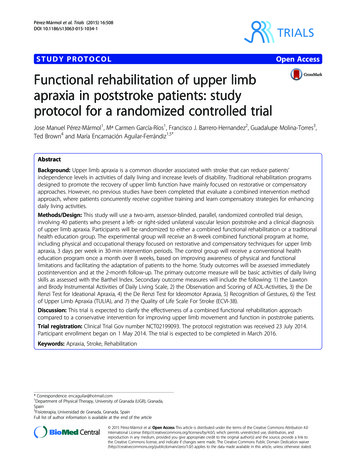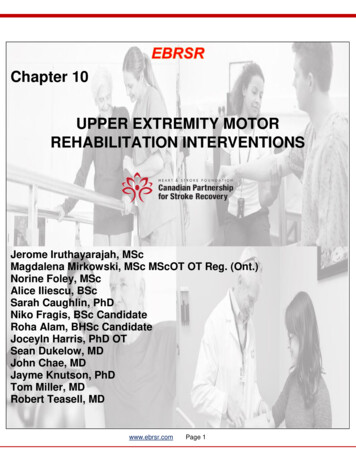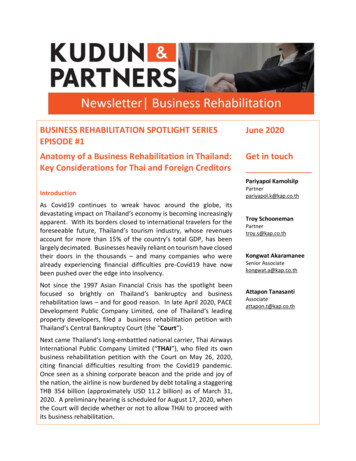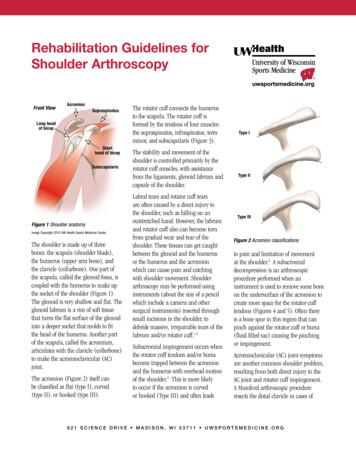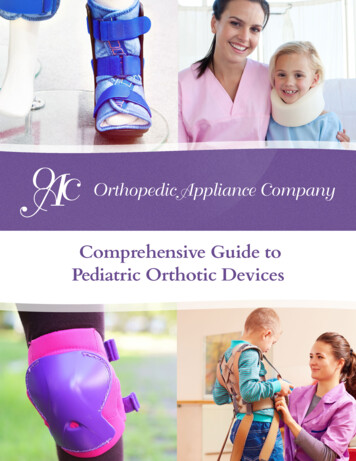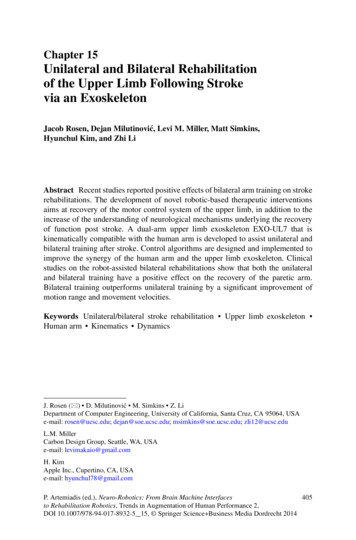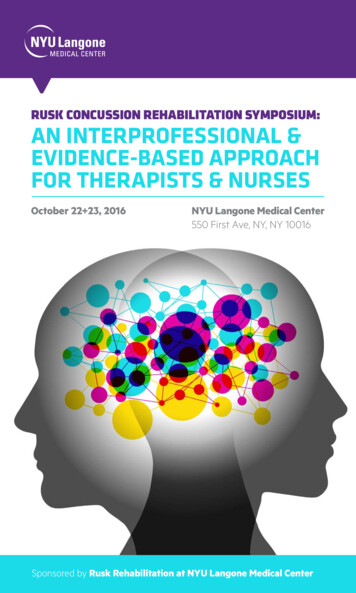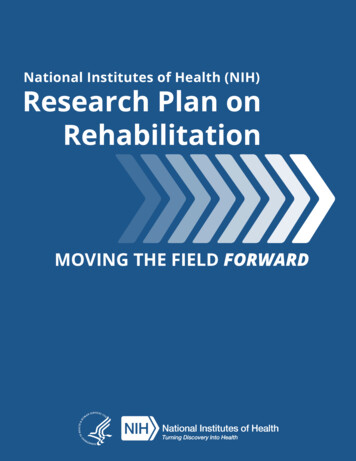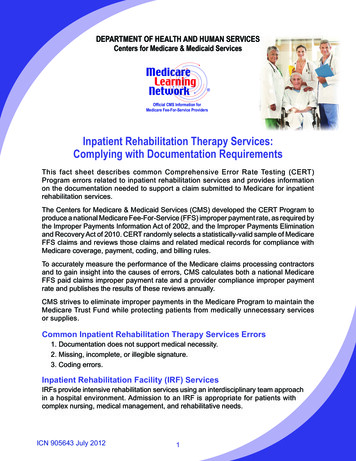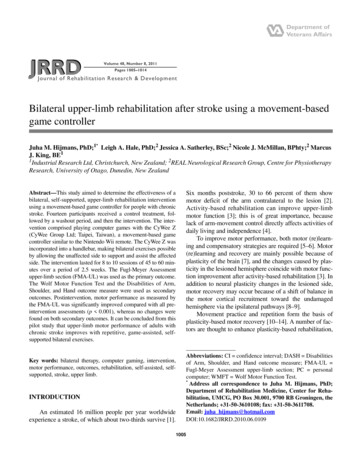
Transcription
JRRDVolume 48, Number 8, 2011Pages 1005–1014Journal of Rehabilitation Research & DevelopmentBilateral upper-limb rehabilitation after stroke using a movement-basedgame controllerJuha M. Hijmans, PhD;1* Leigh A. Hale, PhD;2 Jessica A. Satherley, BSc;2 Nicole J. McMillan, BPhty;2 MarcusJ. King, BE11Industrial Research Ltd, Christchurch, New Zealand; 2REAL Neurological Research Group, Centre for PhysiotherapyResearch, University of Otago, Dunedin, New ZealandAbstract—This study aimed to determine the effectiveness of abilateral, self-supported, upper-limb rehabilitation interventionusing a movement-based game controller for people with chronicstroke. Fourteen participants received a control treatment, followed by a washout period, and then the intervention. The intervention comprised playing computer games with the CyWee Z(CyWee Group Ltd; Taipei, Taiwan), a movement-based gamecontroller similar to the Nintendo Wii remote. The CyWee Z wasincorporated into a handlebar, making bilateral exercises possibleby allowing the unaffected side to support and assist the affectedside. The intervention lasted for 8 to 10 sessions of 45 to 60 minutes over a period of 2.5 weeks. The Fugl-Meyer Assessmentupper-limb section (FMA-UL) was used as the primary outcome.The Wolf Motor Function Test and the Disabilities of Arm,Shoulder, and Hand outcome measure were used as secondaryoutcomes. Postintervention, motor performance as measured bythe FMA-UL was significantly improved compared with all preintervention assessments (p 0.001), whereas no changes werefound on both secondary outcomes. It can be concluded from thispilot study that upper-limb motor performance of adults withchronic stroke improves with repetitive, game-assisted, selfsupported bilateral exercises.Key words: bilateral therapy, computer gaming, intervention,motor performance, outcomes, rehabilitation, self-assisted, selfsupported, stroke, upper limb.INTRODUCTIONAn estimated 16 million people per year worldwideexperience a stroke, of which about two-thirds survive [1].1005Six months poststroke, 30 to 66 percent of them showmotor deficit of the arm contralateral to the lesion [2].Activity-based rehabilitation can improve upper-limbmotor function [3]; this is of great importance, becauselack of arm-movement control directly affects activities ofdaily living and independence [4].To improve motor performance, both motor (re)learning and compensatory strategies are required [5–6]. Motor(re)learning and recovery are mainly possible because ofplasticity of the brain [7], and the changes caused by plasticity in the lesioned hemisphere coincide with motor function improvement after activity-based rehabilitation [3]. Inaddition to neural plasticity changes in the lesioned side,motor recovery may occur because of a shift of balance inthe motor cortical recruitment toward the undamagedhemisphere via the ipsilateral pathways [8–9].Movement practice and repetition form the basis ofplasticity-based motor recovery [10–14]. A number of factors are thought to enhance plasticity-based rehabilitation,Abbreviations: CI confidence interval; DASH Disabilitiesof Arm, Shoulder, and Hand outcome measure; FMA-UL Fugl-Meyer Assessment upper-limb section; PC personalcomputer; WMFT Wolf Motor Function Test.*Address all correspondence to Juha M. Hijmans, PhD;Department of Rehabilitation Medicine, Center for Rehabilitation, UMCG, PO Box 30.001, 9700 RB Groningen, theNetherlands; 31-50-3610108; fax: 31-50-3611708. Email: juha hijmans@hotmail.comDOI:10.1682/JRRD.2010.06.0109
1006JRRD, Volume 48, Number 8, 2011such as task-oriented movement practice in a challenging,engaging, functional, and meaningful way, and the rehabilitation should address body function and structures,activity, and participation level [9–13,15]. Rehabilitationhas shown that, even in chronic stroke, improved upperlimb outcomes can be achieved [16–17].Recovery after stroke correlates with the frequencyand intensity of exercise [11,13,18–19]; however, passivemovement is insufficient to alter motor recovery [19].Active engagement and movement attempts are thoughtto be more important than passive movement, and thefocus should be on movement coordination rather thanmuscle strengthening [19].Moreover, strong evidence exists that bilateral trainingis effective in functional recovery of the upper limb [20–21]. Summers et al. suggest that bilateral synchronousmovement therapy is more effective than similar unilateraltraining [22]. Bilateral therapy is based on the idea thatinvolvement of the unaffected upper limb facilitates learning the spatial and temporal parameters required for motorrecovery of the affected limb [21]. Bilateral training isthought to increase activation of the affected hemisphere,especially the secondary motor areas, by interhemisphericconnections [21–22].Technology-assisted upper-limb training after strokecan provide engaging and task-oriented training in a natural environment using patient-tailored feedback to support(re)learning of motor skills [9]. Computer and video gamescan improve therapy compliance through engagement [13].Gaming consoles like the Nintendo Wii (Nintendo; Redmond, Washington) and the Sony Eyetoy (Sony Computer Entertainment, Inc; Tokyo, Japan) are currently usedin upper-limb stroke rehabilitation, although limited clinicalevidence exists for their effectiveness [23–24]. Consolegames are designed for nondisabled people; therefore, theyare often too fast for people with motor disabilities to use[25] and frequently provide negative feedback when a gameis lost.Robotic therapy has been reported to improve severalmotor control aspects (e.g., muscle-activation pattern,selectivity, and speed) and may have long-term effects [26].Robot-assisted therapy appears to improve motor controlmore than conventional therapy and is suited for rehabilitation in both the acute and subacute phase [26]. However,the advantages probably exist only because a higher intensity of practice can be reached [13,27], resulting inimprovement at a body function and structures level andnot necessarily improvement in activities of daily living[13,26]. A disadvantage of robotic therapy is the cost; thus,an important question regarding the future of robotic rehabilitation is whether similar objectives can be accomplishedby a simpler and more cost-effective approach [28–29].We have developed a system that uses low-cost gaming technology to exercise the affected upper limb ofpeople with stroke while their less-affected arm supportsand assists the movements of the affected arm in a bilateral manner. In this pilot study, we investigate the effectsof this system on motor recovery, which is designed toprovide repetitive, game-assisted upper-limb rehabilitation in adults with chronic stroke.METHODSParticipantsAdult participants at least 6 months poststroke wererecruited from the local community by media advertising.Exclusion criteria comprised no voluntary arm movement,self-reported problems preventing device use (orthopaedic,medical, and/or painful conditions), and an inability tounderstand the project and its requirements.Study DesignIn a control-washout-intervention design, the participants served as their own controls. Participants wereassessed after being enrolled in the study (T0 precontrol).During the initial control period, participants played foursimple mouse-based computer games on a personal computer (PC) with their unaffected arm: Solitaire, Mah-Jong,FreeCell, and Bejeweled. Three participants played on threePCs with one or two therapists supervising during a2.5 week period of 8 to 10 sessions, each lasting between 45and 60 minutes. The participants were retested after the control treatment (T1 postcontrol) and again after 2 to3 weeks (T2 preintervention) during which no interventionwas provided. Finally, participants received the intervention,followed by the last assessment (T3 postintervention).The intervention comprised playing games on a PCusing a CyWee Z game controller (CyWee Group Ltd;Taipei, Taiwan) incorporated into a custom-made handlebar(Figure 1). As in the control treatment, three participantsplayed on three PCs with one or two therapists supervising,the same amount of therapist interaction provided duringthe control treatment. A suite of games provided a graduated series of physical challenges, from strategic, stationary target-hitting games (Bejeweled and Balloon Popping),
1007HIJMANS et al. Poststroke UL rehabilitation using game controllerficient to hold the game controller, a therapist fixed it tothe participant’s wrist with a soft bandage (n 2).Figure 1.CyWee Z game controller (CyWee Group Ltd; Taipei, Taiwan)incorporated into handlebar. (a) “Hands vertical” for exercising radialand ulnar deviation (combined with elbow and shoulder flexion/extension). (b) “Hands horizontal” for exercising wrist flexion/extension (combined with elbow and shoulder flexion/extension).to moving target-hitting games (Mosquito Swat, MusicCatch, and ReBounce) and faster sports games (10-PinBowling and Air Hockey), as well as some casual games(Paint By Numbers) and puzzle games (Mah-Jong and Solitaire). All games required large cursor movements in boththe horizontal and vertical direction. In the first two sessions, the therapist presented three simple target-hittinggames (Mosquito Swat, Music Catch, and ReBounce). Inthe following sessions, the participants could choose whichgame to play—either a new or a known game. The cognitive requirements to play the games were low, because thegames were simple target-hitting games with large, easy-tosee objects; basic sports games; or simple puzzle games,including the well-known Solitaire and Mah-Jong. Mostgames were specifically developed or adapted for peoplewith stroke so that graphics were clear and fast reactionspeed was not required. A therapist would advise the participant to choose an easier game if he or she was not able tocope with the cognitive requirements of a certain game.Movement was the main objective of this study; the gameswere used to guide movements and motivate the participantto move.During each session, the participants made an estimated minimum of 500 repetitions and possibly up to800 repetitions. One repetition could be an up-downmovement, a left-right movement, or (in most cases) acombination of both (e.g., moving cursor from center totop-right corner of screen).If the participants were able to use the CyWee Z trigger button with their affected hand, the CyWee Z wasplaced in that hand (n 11); otherwise, the CyWee Z wasplaced in the unaffected hand. If grip strength was insuf-DeviceThe CyWee Z is a movement-based game controllersimilar to the Nintendo Wii controller. It was incorporated into a handlebar between 350 and 500 mm long(Figure 1). Rotations of the device in the transverseplane produced horizontal mouse cursor translations onthe screen, while rotations in the sagittal plane producedvertical mouse cursor translations (Figure 2).The handlebar could be held two ways (Figure 1):(1) “hands vertical” for exercising radial and ulnar deviation(vertical mouse cursor translations) combined with elbow(vertical and horizontal mouse cursor translations) andshoulder flexion and extension (horizontal mouse cursortranslations), and (2) “hands horizontal” (pronated) for exercising wrist extension and flexion (vertical mouse cursortranslations) combined with elbow (vertical and horizontalmouse cursor translations) and shoulder flexion and extension (horizontal mouse cursor translations). When handswere held horizontal, only non–mouse-clicking games couldbe played. All games required both horizontal and verticalmouse cursor translations. Therefore, wrist, elbow, andshoulder movement of both the affected and the unaffectedsides were required to play. The therapists instructed participants to practice with both hands vertical and hands horizontal and observed every session.Outcome Measures and StatisticsDuring all assessment sessions, therapists performedthe Fugl-Meyer Assessment upper-limb section (FMAUL) [30]; the Wolf Motor Function Test (WMFT) [31];and the Disabilities of Arm, Shoulder, and Hand outcomemeasure (DASH) [32–33]. We used the FMA-UL as theprimary outcome, whereas we considered the WMFT andthe DASH secondary outcomes. We tested the effects ofthe intervention using an analysis of variance for repeatedmeasures ( 0.05 for all statistical tests). Significantwithin-subject effects were Bonferroni adjusted in multiple comparison tests. We used MedCalc version 11 (2009)for all statistical analyses. We recorded the actual timespent on game play and on rest periods within the sessionsduring sessions 3 and 7.
1008JRRD, Volume 48, Number 8, 2011Figure 2.Movements required for controlling cursor on computer screen using CyWee Z game controller (CyWee Group Ltd; Taipei, Taiwan) incorporatedinto handlebar.RESULTSTwenty-two adults poststroke were recruited, ofwhich 16 were eligible for this study. One person droppedout before the start of the trial and another dropped outbefore the intervention because of family commitments.Five women and nine men with an average age of 71 12(mean standard deviation; range: 47–85) completed the
1009HIJMANS et al. Poststroke UL rehabilitation using game controllertrial. Eight participants had had a stroke in their left hemisphere and six in their right. One person was left-arm dominant prestroke with the left arm affected by the stroke; so,in nine participants the dominant hand was affected and infive the nondominant. The control therapy was played withthe unaffected hand (5 dominant and 9 nondominant).Eleven participants used the trigger of the CyWee Z withtheir affected hand. Three participants had insufficient gripto use the trigger with their affected hand; therefore, theyused the CyWee Z with their unaffected hand. Time sincestroke was between 1 and 6 years. The mean FMA-ULscore at inclusion was 44.2 17.9 and ranged from 14 to 65(maximum score: 66).The Table shows the outcomes at T0, T1, T2, and T3.A significant within-subject session effect was found onthe primary outcome measure, the FMA-UL (p 0.001).In a multiple comparison test (Bonferroni corrected), theFMA-UL score at T3 was significantly higher than at T0,T1, and T2, with an average increase and 95 percent confidence interval (CI) of 5.00 (CI: 1.45–8.55; p 0.005), 5.23(CI: 1.80–8.66; p 0.003), and 4.23 (CI: 1.81–6.66; p 0.001), respectively.No significant within-subject or multiple comparisoneffects were found on the WMFT and the DASH (Table).Of the 14 participants who completed the trial, onemissed the T1 assessment; therefore, we did not take theoutcomes of this participant into account in the statisticalanalyses. When we performed the same statistical analyses on T0, T2, and T3 (n 14), the same outcomesremained significant (data not presented).Average session time increased from 49.3 to 52.1 minutes between intervention sessions 3 and 7. The averagecumulative rest time during sessions decreased from 3.6 to1.0 minutes, meaning that the actual game-play timeincreased by 11 percent between sessions 3 and 7.DISCUSSIONThis is the first study conducted using the CyWee Z asan upper-limb rehabilitation tool and using self-assistedbilateral movements with a movement-based game controller. This pilot study showed that repetitive, bilateralgame-assisted exercises using the CyWee Z incorporatedinto a handlebar improved upper-limb motor performancemeasured by the FMA-UL. Even though the group comprised adults with chronic stroke, the cohort was heterogeneous (FMA-UL scores ranged from 14 to 65 at inclusion),and even though the intervention had only 8 to 10 sessions,the intervention improved motor performance significantly. The mean improvement as an effect of the intervention ranged from 4.2 (compared with T2) to 5.2 (comparedwith T1). These results are comparable with the moreintensive robotic-aided therapies reported by Prange et al.,with FMA-UL score improvements between 3.4 and 6.1[26]. Others have also shown that a highly repetitive, synchronous bilateral intervention over a short duration, albeitwith no mechanical or computer device included, can beeffective [22].We found no effects on the WMFT and the DASH;the possible explanation for this is that the interventionfocused on repetitive arm movements and not on functional or participatory arm activities. The DASH, a selfreport questionnaire, assesses upper-limb function at anactivity and participation level, whereas the FMA-ULassesses the upper limb on the body function and structures level [34]. The WMFT is a timed, performancebased measure that measures the speed of performingmotor tasks. It can take time for people to incorporatebody function and structure improvement and increasedtask-performance speed, and because assessment was carried out immediately after a relatively short intervention,the WMFT may not be responsive enough to measurechange in such a time frame. The low intensity of theTable.Mean standard deviation of outcome measures precontrol (T0), postcontrol (T1), preintervention (T2), and postintervention (T3).OutcomeMeasure*T0T1T2T3Fp-ValueFMA-UL44.2 17.944.0 17.245.0 16.249.2 16.610.41 0.001WMFT32.7 50.432.4 50.631.5 50.930.5 51.22.740.06DASH51.8 21.554.5 23.455.0 24.455.6 23.20.660.58*n 13.DASH Disabilities of Arm, Shoulder, and Hand outcome measure (increase in score indicates improvement); FMA-UL Fugl-Meyer Assessment upper-limbsection (increase in score indicates improvement); WMFT Wolf Motor Function Test (decrease in score indicates improvement).
1010JRRD, Volume 48, Number 8, 2011intervention compared with constraint-induced therapycould be another explanation for the lack of change measured by the WMFT. Additionally, the WMFT includesmovement tasks more frequently performed by the dominant hand but does not consider dominance.We incorporated the CyWee Z into a handlebar forseveral reasons. First, the unaffected side can support andassist the affected side in a bilateral manner by using thehandlebar. Bilateral therapy has proven to be effective infunctional recovery of the upper limb [20–21]. Second,rotation of the CyWee Z results in synchronous bilateralgross motor movements with the handlebar, whereaswhile the CyWee Z is held in one hand without the handlebar, only limited wrist movement is needed to controlthe cursor. Third, the handlebar can be placed on the lapas a support against gravity yet still enable gross motormovement if the user has difficulty lifting the device. Intheir review of bilateral therapy, Latimer et al. suggest thatbilateral training provides the requirements considerednecessary for motor relearning and focuses on the importance of active involvement of the affected side ratherthan the affected hand being driven by a robot or the unaffected side [21]. Bilateral training using the CyWee Zrequires this active involvement of the affected upperlimb.The CyWee Z is a movement-based game controllersimilar to the Nintendo Wii but coupled to a PC. Therefore, it is possible to develop and use games paced to suit auser’s ability level. This system provides a platform forself-assisted, engaging, highly repetitive, and task-orientedbilateral training of the upper limb, all modalities crucialfor motor recovery following stroke [13,27]. Previously,expensive robotic therapy was seen as the only way todeliver such a therapy [29].Overall, game play appeared to be engaging andacceptable for participants. A range of games was provided that had various levels of challenge, and participantsselected games according to their own ability and preference. All participants were able to use the equipment.Some participants played only the cognitively easiestgames and frequently needed the therapist’s help to manage the PC; others played all games, including the morechallenging sports games, without assistance. A possibilityfor improvement could be performance-driven games,where the patient’s performance dictates future session targets [34], ensuring that each participant works at an appropriate level.This pilot trial had limitations. The research designused was a pre-baseline-post design in which the participants were observed over time. It was not possible toblind the assessors, and no control group was recruited.In this study, all participants received the control treatment first, followed by the intervention. In general, adesign in which 50 percent of the participants receive theintervention first and 50 percent receive the control treatment first would be a preferable approach. We chose notto use this approach, because if natural recovery wouldstill take place, more recovery would be expected soonerpoststroke (during the first weeks of the study). In ourdesign, more natural recovery was expected during thecontrol therapy. Therefore, it was possible to demonstratethat the intervention showed more improvement than natural recovery in combination with a control intervention. Wecontrolled for therapist-interaction effect by using a control treatment consisting of the same amount of therapistinteraction time as during the actual intervention. Nodifferences were found between the control treatment andthe washout period. Therefore, therapist-interaction timeappeared not to bias our results. Only the immediateeffects were studied; a follow-up study should be performed to study the long-term effects of the intervention.Four participants mentioned shoulder pain during andafter the intervention. This pain did not prevent them fromparticipating but should be considered when the game controller is used more frequently, for a longer duration, orwithout supervision. The first few sessions appearedfatiguing for most participants, reflected by the shorter session lengths and longer break times in session 3 than insession 7. While quantity, duration, and intensity areimportant variables in (re)learning motor skills and changing neural structure [35], these results suggest that the startof an upper-limb rehabilitation program may need a ramping regime to slowly increase quantity, duration, and intensity to ensure that sessions are pain free.CONCLUSIONSThis study showed that computer-assisted, bilateralupper-limb rehabilitation using a low-cost game controllercan significantly improve upper-limb function over a shortduration in adults with chronic stroke. Engaging in computer games using a CyWee Z incorporated into a handlebar seems to be a cost-effective alternative to other formsof therapy, such as robotic, catering toward repetitive,
1011HIJMANS et al. Poststroke UL rehabilitation using game controllerself-supported upper-limb exercises. Therefore, based onthis study, performing a larger-scale controlled trial with alonger intervention duration and follow-up is recommended. We expect further improvements when the gamecontroller is used over increasingly longer sessions with alonger intervention period.ACKNOWLEDGMENTSAuthor Contributions:Study concept and design: M. J. King, J. M. Hijmans.Acquisition of data: J. A. Satherley, N. J. McMillan.Analysis and interpretation of data: J. M. Hijmans.Drafting of manuscript: J. M. Hijmans.Critical revision of manuscript for important intellectual content:L. A. Hale, M. J. King.Statistical analysis: J. M. Hijmans.Obtained funding: M. J. King.Administrative, technical, or material support: M. J. King.Study supervision: L. A. Hale.Financial Disclosures: The authors have declared that no competinginterests exist.Funding/Support: This material was based on work supported by theFoundation for Research Science and Technology, New Zealand (contract CO8X0816).Additional Contributions: The authors thank the participants, whowillingly gave their time and ideas during intervention trial, and Cerebralfix, New Zealand, for supplying the majority of the computergames. Dr. Hijmans is now with the Department of RehabilitationMedicine, Center for Rehabilitation, University Medical CenterGroningen, Groningen, the Netherlands.Institutional Review: All participants signed informed consent formsand the study was approved by the University of Otago Human EthicsCommittee (09/193).Participant Follow-Up: The participants have already been informedof the intent to publish. Authors do not intend to provide the details ofpublication to participants directly; they will be informed throughpublic access to the academic Web site.REFERENCES1. Strong K, Mathers C, Bonita R. Preventing stroke: Savinglives around the world. Lancet Neurol. 2007;6(2):182–87.[PMID: 17239805] DOI:10.1016/S1474-4422(07)70031-52. Kwakkel G, Kollen BJ, Wagenaar RC. Therapy impact onfunctional recovery in stroke rehabilitation: A critical reviewof the literature. Physiotherapy. 1999;85(7):377–91. DOI:10.1016/S0031-9406(05)67198-23. Richards LG, Stewart KC, Woodbury ML, Senesac C, Cauraugh JH. Movement-dependent stroke recovery: A system-atic review and meta-analysis of TMS and fMRI evidence.Neuropsychologia. 2008;46(1):3–11. [PMID: 17904594] DOI:10.1016/j.neuropsychologia.2007.08.0134. Whitall J, McCombe Waller S, Silver KH, Macko RF. Repetitive bilateral arm training with rhythmic auditory cueingimproves motor function in chronic hemiparetic stroke.Stroke. 2000;31:2390–95. [PMID: 11022069]5. Langhorne P, Coupar F, Pollock A. Motor recovery afterstroke: A systematic review. Lancet Neurol. 2009;8(8):741–54. [PMID: 19608100] DOI:10.1016/S1474-4422(09)70150-46. Krakauer JW. Motor learning: Its relevance to stroke recovery and neurorehabilitation. Curr Opin Neurol. 2006;19(1):84–90. [PMID: 16415682] DOI:10.1097/01.wco.0000200544.29915.cc7. Hallett M. Plasticity of the human motor cortex and recovery from stroke. Brain Res Rev. 2001;36(2–3):169–74. [PMID: 11690613] DOI:10.1016/S0165-0173(01)00092-38. Jang SH. A review of the ipsilateral motor pathway as arecovery mechanism in patients with stroke. NeuroRehabilitation. 2009;24(4):315–20. [PMID: 19597268]9. Timmermans AA, Seelen HA, Willmann RD, Kingma H.Technology-assisted training of arm-hand skills in stroke:Concepts on reacquisition of motor control and therapistguidelines for rehabilitation technology design. J NeuroengRehabil. 2009;6:1. [PMID: 19154570] DOI:10.1186/1743-0003-6-110. Krouchev NI, Kalaska JF. Virtual worlds and games forrehabilitation and research. Virtual Rehabil. 2008:113–20.11. Cameirão MS, Badia SB, Verschure PF. Virtual realitybased upper extremity rehabilitation following stroke: Areview. J Cyber Ther Rehabil. 2008;1(1):63–74.12. Sveistrup H. Motor rehabilitation using virtual reality. J Neuroeng Rehabil. 2004;1(1):10. [PMID: 15679945] DOI:10.1186/1743-0003-1-1013. Kwakkel G, Kollen BJ, Krebs HI. Effects of robot-assistedtherapy on upper limb recovery after stroke: A systematicreview. Neurorehabil Neural Repair. 2007;22(2):111–21. [PMID: 17875068] DOI:10.1177/154596830730545714. Woldag H, Hummelsheim H. Evidence-based physiotherapeutic concepts for improving arm and hand function instroke patients: A review. J Neurol. 2002;249(5):518–28. [PMID: 12021939] DOI:10.1007/s00415020005815. World Health Organization. International classification offunctioning, disability, and health: ICF. Geneva (Switzerland): WHO Publishing; 2011.16. Van der Lee LH, Wagenaar RC, Lankhorst GJ, Vogelaar TW,Deville WL, Bouter LM. Forced use of the upper extremity in
1012JRRD, Volume 48, Number 8, 2011chronic stroke patients: Results from a single-blind randomized clinical trial. Stroke. 1999;30(11):2369–75. [PMID: 10548673]17. Page SJ, Gater DR, Bach-Y-Rita P. Reconsidering themotor recovery plateau in stroke rehabilitation. Arch PhysMed Rehabil. 2004;85(8):1377–81. [PMID: 15295770] DOI:10.1016/j.apmr.2003.12.03118. Henderson A, Korner-Bitensky N, Levin M. Virtual reality instroke rehabilitation: A systematic review of its effectivenessfor upper limb motor recovery. Top Stroke Rehabil. 2007;14(2):52–61. [PMID: 17517575] DOI:10.1310/tsr1402-5219. Krebs HI, Volpe B, Hogan N. A working model of strokerecovery from rehabilitation robotics practitioners. J NeuroengRehabil. 2009;25(6):6. [PMID: 19243615] DOI:10.1186/1743-0003-6-620. Cauraugh JH, Lodha N, Naik SK, Summers JJ. Bilateralmovement training and stroke motor recovery progress: Astructured review and meta-analysis. Hum Mov Sci. 2010;29(5):853–70. [PMID: 19926154] DOI:10.1016/j.humov.2009.09.00421. Latimer CP, Keeling J, Lin B, Henderson M, Hale LA. Theimpact of bilateral therapy on upper limb function afterchronic stroke: A systematic review. Disabil Rehabil. 2010;32(15):1221–31. [PMID: 20156045] DOI:10.3109/0963828090348387722. Summers JJ, Kagerer FA, Garry MI, Hiraga CY, Loftus A,Cauraugh JH. Bilateral and unilateral movement training onupper limb function in chronic stroke patients: A TMS study.J Neurol Sci. 2007;252(1):76–82. [PMID: 17134723] DOI:10.1016/j.jns.2006.10.01123. Yavuzer G, Senel A, Atay MB, Stam HJ. “Playstation EyeToy games” improve upper extremity-related motor functioning in subacute stroke: A randomized controlled clinicaltrial. Eur J Phys Rehabil Med. 2008;44(3):237–44. [PMID: 18469735]24. Saposnik G, Mamdani M, Bayley M, Thorpe KE, Hall J,Cohen LG, Teasell R; EVREST Study Group for the StrokeOutcome Research Canada Working Group. Effectivenessof Virtual Reality Exercises in STroke Rehabilitation(EVREST): Rationale, design, and protocol of a pilot randomized clinical trial assessing the Wii gaming system. IntJ Stroke. 2010;5(1):47–51. [PMID: 20088994] DOI:10.1111/j.1747-4949.2009.00404.x25. Grammenos D, Savidis A, Georgalis Y, Stephanidis C.Access invaders: Developing a universally accessible actiongame. Computers Helping People with Special Needs, Proceedings of the 10th International Conference, ICCHP; 2006Jul 12–14; Linz, Austria. Berlin Heidelberg (Germany):Springer; 2006. p. 388–95.26. Prange GB, Jannink MJ, Groothuis-Oudshoorn CG, Hermens HJ, IJzerman MJ. Systematic review of the effect ofrobot-aided therapy on recovery of the hemiparetic armaf
experience a stroke, of which about two-thirds survive [1]. Six months poststroke, 30 to 66 percent of them show motor deficit of the arm contralateral to the lesion [2]. Activity-based rehabilitation can improve upper-limb motor function [3]; this is of great importance, because la
